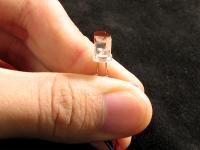May 17 2010
A miniaturized chip of silicon that functions like a nose is capable of sensing airborne chemicals in the future for alerting emergency responders through the mobile phone network.
 Hundreds of seperate spots on the flake of Silicon can be engineered to change color in response to many different chemicals
Hundreds of seperate spots on the flake of Silicon can be engineered to change color in response to many different chemicals
According to the developers, embedding this sensor in many mobile phones would help in the mapping of locations and the extent of hazards such as deliberate toxin discharge or gas leaks.
The University of California’s biochemistry and chemistry professor Michael Sailor informs that this technology is capable of mapping chemical accidents as they unfold since mobile phones are present everywhere users are. His research team at the UCSD is collaborating with a small San Diego-based start up firm to complete the first stage of development of this sensor and is currently working on a prototype for connecting to a mobile phone.
The porous silicon flake sensor changes its color while reacting with particular chemicals. The researchers manipulated the pores’ shapes for tuning individual spots in the flake for responding to particular chemical traits.
Now these chips are able to differentiate between toluene and methyl salicylate. Methyl salicylate is a chemical compound utilized for stimulation of mustard gas that is a chemical warfare agent, while toluene is used as a common additive for gasoline. These chips have the potential for discriminating among many types of different chemical compounds and identify the harmful ones.
An image present on the nanopores array of the chip is captured by a megapixel camera that is smaller than a pencil eraser’s head. The team is utilizing a new form of supermacro lens that functions more as an eye of an animal rather than a camera lens. This Rhevision developed lens utilizes fluid instead of heavy moving parts for changing the shape and focus.
Developing its sensitivity for additional chemicals is in progress. The deadly carbon monoxide remains among the top priorities of emergency responders, which firefighters are not able to smell in the middle of a sooty fire. According to Sailor, sensors fixed on the masks of the firefighters should give them information on when to switch on to self contained breathing gadgets. These sensors will be able to warn miners when explosive gases are in the buildup stage.
The Department of Homeland Security is funding this project.
Sailor revealed that particular chemical properties can be sensed through a range of sensory cells. The brain is able to recognize a particular smell through an activity pattern across the sensors array. In the similar way the color pattern changes on the chips’s surface to reveal the chemical’s identity.